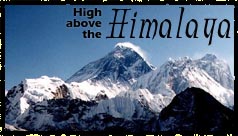 |
 |
 |
|
|||
|
High Above the Himalaya
I wonder if the deities my ancestors believed live on these mountains, ever tire of droning planes that ferry tourists in their bellies. Does it disturb their slumber? Do gods sleep late? I look at the printed profile of the mountains the pretty air hostess handed me when I boarded. They look like a child's sketch - pyramids lined up in a row. How am I going to be able to tell one mountain from the next, I wonder. We've left the runway and the plane is gaining altitude. As we leave Kathmandu Valley's ancient temples and stupas behind, snow-white peaks start to unfurl to the left. We're at 13,000 feet and still climbing. I ask the person across the narrow aisle if this is his first mountain flight
This is my first evening flight too, my first mountain flight, I explain. When the rays of the setting sun reflect off of the snow, he says, it bathes the mountains in a glory of light and color.
If all the mountains in the Himalaya were given gender, Langtang, with its elegant, fluted ridges, would be a lady. Now, this mountain looks like combs carved out of ice. Hmm, what do you know, it's called Shisha Pangma, or combs rising from a flat place. Of all the mountains, I have to confess Gaurishankar is my favorite. The delightful pinnacles that cap the mountain - named after Shiva and his consort Gauri - evoke images of a woman on her lover's lap. I begin to notice that each mountain has a distinct shape and personality. The pilot tells me over 20 mountains are on our flight path and that eight of the world's ten highest mountains are in Nepal. Isn't it amazing what nature creates? The Himalaya formed some 200 million years ago as the Asian plate collided with the Indian Plate. Many ranges arose from the Tethis seabed and surrounding landmass. So now there is the main crest, called the Great Himalaya, and to its north, west and south stretch other parallel and lesser ranges. All but one of the world's mountains taller than 23,000 feet lie in this profusion of ranges that we call the Greater Himalaya.
The sun is about to set. There's a film-maker among the passengers, making a promotional. The pilot tells me he will make as many circles around Everest as is needed to "capture" it on film. I sit back and think of all the wars men have fought over centuries, prophets born over ages, and civilizations come and gone. To imagine that these mountains have been here all along - a silent testimony to history, religion and mythology. Imagine yourself in the front seat of a moving theater. A visual documentary unfolding right in front of you: Everest, Chomolongma, Sagarmatha - the one whose forehead touches the sky. As it floats on a sea of clouds, the harsh peak that has swallowed so many accomplished mountaineers looks almost benign. We circle Everest five times. And I see the most dramatic change of colors.
As we approached from Kathmandu, Everest had loomed over others - dark, angry and dangerous. But now, as we make our first loop, we see the rays of the setting sun softening its harsh lines. The mountain starts to light up and as we make our third loop, Everest looks as if it is made of burnished gold. And as the sun dips and disappears over the horizon, the entire range turns silver. As we complete our fifth loop, the sky starts to turn gray. The mountains that had displayed so much character, so much power, turn into a shadow of themselves. And then darkness. From the skies above the Himalaya, this is Manisha Aryal for The Savvy Traveler. For more information:
|
 | American Public Media Home | Search | How to Listen ©2004 American Public Media | Terms of Use | Privacy Policy |

